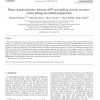Free Online Productivity Tools
i2Speak
i2Symbol
i2OCR
iTex2Img
iWeb2Print
iWeb2Shot
i2Type
iPdf2Split
iPdf2Merge
i2Bopomofo
i2Arabic
i2Style
i2Image
i2PDF
iLatex2Rtf
Sci2ools
IJON
2007
2007
Phase synchronization between LFP and spiking activity in motor cortex during movement preparation
A common approach to measure and assess cortical dynamics focuses on the analysis of mass signals, such as the local field potential (LFP), as an indicator for the underlying network activity. To improve our understanding of how such field potentials and cortical spiking dynamics are related, we analyzed the phase and amplitude relationships between extracellular recordings from motor cortex of monkey in a delayed pointing task. We applied methods from phase synchronization analysis to extract the instantaneous phase of the LFP time series and to characterize the degree of phase coupling between the spike train and oscillation cycles in a frequencyindependent manner. In particular, we investigated the dependence of observed phase preferences on the different periods of a behavioral trial. Furthermore, we present evidence to support the hypothesis that increased LFP oscillation amplitudes are related to a stronger degree of synchronization between the LFP and spike signals. However, ...
| Added | 15 Dec 2010 |
| Updated | 15 Dec 2010 |
| Type | Journal |
| Year | 2007 |
| Where | IJON |
| Authors | Michael Denker, Sébastien Roux, Marc Timme, Alexa Riehle, Sonja Grün |
Comments (0)

